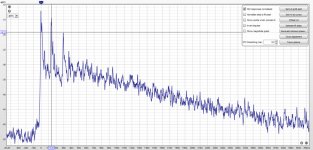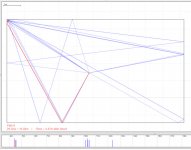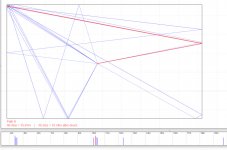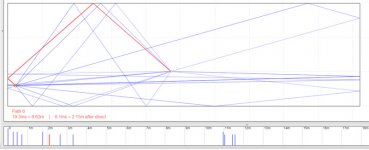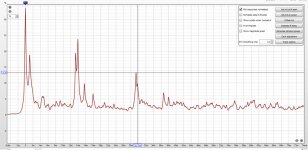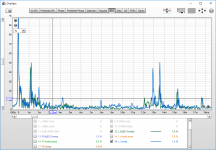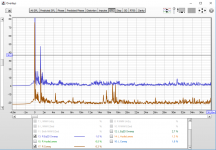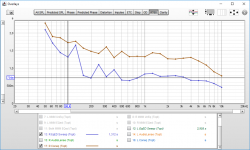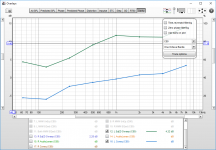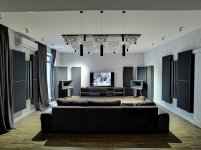Hi,
First there won't be any issue to mix 1D and 2D diffusors, it is often seen used this way in backwall of pro control room.
The real difference between the 2 is 'efficiency' in scattering: 1D are most often more effective than their 2D siblings ( with equal bandwidth of effect).
I agree with Adason and Rayma: symmetry of treatments is important.
About your right wall there will probably be an imbalance even with a panel ( except if you manage to have exactly the same kind of behavior than the glass and drape on the other side).
Maybe it is possible to have another curtain over some mirrors on the right side to duplicate the left side? That way you may have an acoustic symmetrical behavior and a visually 'pleasing' room ( ymmv of course but a mirror would make the room seems bigger and bring feeling of even more 'light'/space) and curtain can be open or closed to be less visually intrusive in case you are not into critical listening session?
Are the diffusors on ceiling permanently fixed? You could try another pattern than square one if not: something like a big V ( triangle with the point toward the frontwall).
Did it improved the listening experience?
It probably had not much impact over RT but should have make L/R ( soundstage) more focused.
As you have a relatively high ceiling height, If you want to lower RT at same time you could consider separate/ push away diffusor tiles from ceiling ( like 20cm away) and put some absorbent material like rockwool directly over the tiles ( 10cm/4" depth) and a plenum to the ceiling ( empty space, in the 10cm/4"depth range). It could help from ~200hz and up to lower reverberation time.
Of course it'll require a bit of imagination to do it and may be unacceptable from a visual pov, but it'll be effective ( it is the same basic idea than use rockfon tiles over the whole ceiling + rockwool to make a wide bandwith 'bass trap' previously suggested).
I think Kipman suggestion about multisub approach to be a good answer too ( either Dba or multisub 'a la Geddes').
First there won't be any issue to mix 1D and 2D diffusors, it is often seen used this way in backwall of pro control room.
The real difference between the 2 is 'efficiency' in scattering: 1D are most often more effective than their 2D siblings ( with equal bandwidth of effect).
I agree with Adason and Rayma: symmetry of treatments is important.
About your right wall there will probably be an imbalance even with a panel ( except if you manage to have exactly the same kind of behavior than the glass and drape on the other side).
Maybe it is possible to have another curtain over some mirrors on the right side to duplicate the left side? That way you may have an acoustic symmetrical behavior and a visually 'pleasing' room ( ymmv of course but a mirror would make the room seems bigger and bring feeling of even more 'light'/space) and curtain can be open or closed to be less visually intrusive in case you are not into critical listening session?
Are the diffusors on ceiling permanently fixed? You could try another pattern than square one if not: something like a big V ( triangle with the point toward the frontwall).
Did it improved the listening experience?
It probably had not much impact over RT but should have make L/R ( soundstage) more focused.
As you have a relatively high ceiling height, If you want to lower RT at same time you could consider separate/ push away diffusor tiles from ceiling ( like 20cm away) and put some absorbent material like rockwool directly over the tiles ( 10cm/4" depth) and a plenum to the ceiling ( empty space, in the 10cm/4"depth range). It could help from ~200hz and up to lower reverberation time.
Of course it'll require a bit of imagination to do it and may be unacceptable from a visual pov, but it'll be effective ( it is the same basic idea than use rockfon tiles over the whole ceiling + rockwool to make a wide bandwith 'bass trap' previously suggested).
I think Kipman suggestion about multisub approach to be a good answer too ( either Dba or multisub 'a la Geddes').
Last edited:
Placing a mirror with a drape sounds like a good idea!
As for the diffusers - they have been fixed almost permanently, yes. It will be a huge mess if I remove them.
As for the improvements - didn't have a chance to give it a listen yet. Will report back as soon as I do.
As for the diffusers - they have been fixed almost permanently, yes. It will be a huge mess if I remove them.
As for the improvements - didn't have a chance to give it a listen yet. Will report back as soon as I do.
I think I am done with the ceiling for the moment.
I have 6 Arqen Leanfusers which will be placed on the back wall, which makes 9sq/meters - a half of the back wall area.
And I also have 10 2x0.6 meters broad band panels with 4" rockwool and 2" gap. Those will be placed along the side walls. On the front wall I will put 4 additional 1x0.6 absorbers.
I have 6 Arqen Leanfusers which will be placed on the back wall, which makes 9sq/meters - a half of the back wall area.
And I also have 10 2x0.6 meters broad band panels with 4" rockwool and 2" gap. Those will be placed along the side walls. On the front wall I will put 4 additional 1x0.6 absorbers.
Have you performed some measurements?
I would be careful not to overtreat bands which doesn't need it with absorbsion.
Imo it is better to have coherency over the whole RT ( even if -a bit- longer than optimal) than frequency range which are too dead ( too short RT) wrt the lower ones.
I would be careful not to overtreat bands which doesn't need it with absorbsion.
Imo it is better to have coherency over the whole RT ( even if -a bit- longer than optimal) than frequency range which are too dead ( too short RT) wrt the lower ones.
Was playing with EQ today and checked RT times as well. Here are RTs after i installed ceiling and backwall diffusers:

As can be seen from the first post in this thread, RTs were near 1.5-1.8s before diffusers. Now, most of the freqs are near 1s. Interesting 🙂 And the fall in RT in 2K to 10K region is not as deep as before the treatment.
Still have huge problems in low and very low frequencies. Hope to get rock wool broadband absorbers ready and installed by the end of next week.
As can be seen from the first post in this thread, RTs were near 1.5-1.8s before diffusers. Now, most of the freqs are near 1s. Interesting 🙂 And the fall in RT in 2K to 10K region is not as deep as before the treatment.
Still have huge problems in low and very low frequencies. Hope to get rock wool broadband absorbers ready and installed by the end of next week.
Attachments
Last edited:
Trying to learn how to use Impulse graph with ETC view.
Here is a bit smoothed version of it:

See some strong energy spikes at about 14ms and 30ms after the initial.
And then i found AmRay tool which allow to draw a simple room and see the sound as rays and how those ray reflect around the room and get to the listener.
According to how the tool, side reflections are happening at around 4.5ms after the initial:

Bounce from back wall is at around 10ms from the start:

And floor/ceiling bounce also happen quite early:

So I have no idea what is happening at 14 and 30ms. If 14ms is back wall reflection why it is louder that side wall reflections?
Here is ETC % view, where those spikes can be seen more clearly:

Am I interpreting this graph correctly?
Here is a bit smoothed version of it:
See some strong energy spikes at about 14ms and 30ms after the initial.
And then i found AmRay tool which allow to draw a simple room and see the sound as rays and how those ray reflect around the room and get to the listener.
According to how the tool, side reflections are happening at around 4.5ms after the initial:
Bounce from back wall is at around 10ms from the start:
And floor/ceiling bounce also happen quite early:
So I have no idea what is happening at 14 and 30ms. If 14ms is back wall reflection why it is louder that side wall reflections?
Here is ETC % view, where those spikes can be seen more clearly:
Am I interpreting this graph correctly?
Attachments
Hi,
Could'nt the 14 and 30 ms be related to the 130hz peak in the graph in your first post?
Maybe a low freq early reflection?
Do you have a sonograph/wavelet view to share, it could help identify from where they come from.
Except those two peaks the rest looks fine to me, maybe a bit more absorbsion to lower RT a bit more and it should be very nice.
If you treat first reflection point ( wall) with panel (or drapes) it should be effective from 1khz and up.
The range 300/900hz could benefit of a bit of attention too.
Could'nt the 14 and 30 ms be related to the 130hz peak in the graph in your first post?
Maybe a low freq early reflection?
Do you have a sonograph/wavelet view to share, it could help identify from where they come from.
Except those two peaks the rest looks fine to me, maybe a bit more absorbsion to lower RT a bit more and it should be very nice.
If you treat first reflection point ( wall) with panel (or drapes) it should be effective from 1khz and up.
The range 300/900hz could benefit of a bit of attention too.
Last edited:
So i've installed absorbers and here is how the whole picture looks like now:

Also, here are some measurements:
ETC:

ETC2:

Impulse:

RT60:

Clarity:

A bit on the sound - it is like night and day. Very big difference. I don't have much experience listening to great acoustics in properly treated rooms but this is the closest thing i've ever heard to "WOW SOUNDS GREAT" 🙂
Also, here are some measurements:
ETC:
ETC2:
Impulse:
RT60:
Clarity:
A bit on the sound - it is like night and day. Very big difference. I don't have much experience listening to great acoustics in properly treated rooms but this is the closest thing i've ever heard to "WOW SOUNDS GREAT" 🙂
Attachments
Last edited:
Whenever I see a thread on room treatment on any site what I never see is any mention at all of what materials are used for walls, ceiling or floor, that surely has to be the start point. I remember someone who moved from a late Georgian (1800 ish) house(UK) to a modern one with those awful stud and plasterboard internal walls who complained that he had lost the bass. Here in France where I live I really wonder why more people don't just use h/phones because of the awful materials that are used in construction, coupled with the fact that internal walls in old houses are usually only 7.5cm and they are built using hollow clay blocks which then receive a hard plaster finish. New houses are built using the same materials for external walls, the only difference is the depth and internal walls are usually made using single skin (cowboying) plasterboard. The same kind of construction is used in Spain as well - bloody awful for music and zero privacy as well.
So it would be nice to know exactly what materials have been used in the O/Ps listening room?
Before spending good money on specialist products there are few things that are worth looking into. Firstly - there is no coving used, not only does coving remove right angles at ceiling level but it makes the room far more attractive. There is plaster coving and duropolymer, a harder form of polystryrene, nowadays these materials are treated with a fire retardant. Are the walls single skin plasterboard then by removing the skirting board (should'nt be difficult). Then I see relief patterned wallpaper, what a shame because it would have been easier to put up a second skin of plasterboard. I have never seen 'lining paper' anywhere in France - this is just paper used over plaster/plasterboard in the UK which is then painted. The 2 grades that are useful are 1200 and 1400 grade. Crossed lined - that is the 1st is hung horizontally and the 2nd hung vertically, this gives a soft finish to the plasterboard or clay block walls. Ceiling - tongue and groove pine on small battens of the same material - you can stain or oil with whatever suits your taste and will add timbre and warmth to the overall sound.
Krivium's recs are very good for a studio but for a domestic room? - is the WAF factor relevant?
I use antique Flemish 'tafelkleiden' table carpets, copies of Eastern carpets that the Dutch and Flemish refused to use on their floors because they would be destroyed over time with sand and grit. You can buy traditional kelims or very modern versions. Far more attractive. A shame there isn't the room either side of the windows to use insulating shutters rather than curtains. Choosing the right materials would trounce any curtain materials for both insulation and better sound. I see the Op has an A/|C unit fitted - oh dear.
So it would be nice to know exactly what materials have been used in the O/Ps listening room?
Before spending good money on specialist products there are few things that are worth looking into. Firstly - there is no coving used, not only does coving remove right angles at ceiling level but it makes the room far more attractive. There is plaster coving and duropolymer, a harder form of polystryrene, nowadays these materials are treated with a fire retardant. Are the walls single skin plasterboard then by removing the skirting board (should'nt be difficult). Then I see relief patterned wallpaper, what a shame because it would have been easier to put up a second skin of plasterboard. I have never seen 'lining paper' anywhere in France - this is just paper used over plaster/plasterboard in the UK which is then painted. The 2 grades that are useful are 1200 and 1400 grade. Crossed lined - that is the 1st is hung horizontally and the 2nd hung vertically, this gives a soft finish to the plasterboard or clay block walls. Ceiling - tongue and groove pine on small battens of the same material - you can stain or oil with whatever suits your taste and will add timbre and warmth to the overall sound.
Krivium's recs are very good for a studio but for a domestic room? - is the WAF factor relevant?
I use antique Flemish 'tafelkleiden' table carpets, copies of Eastern carpets that the Dutch and Flemish refused to use on their floors because they would be destroyed over time with sand and grit. You can buy traditional kelims or very modern versions. Far more attractive. A shame there isn't the room either side of the windows to use insulating shutters rather than curtains. Choosing the right materials would trounce any curtain materials for both insulation and better sound. I see the Op has an A/|C unit fitted - oh dear.
https://www.diyaudio.com/community/...d-directivity-diys.280249/page-2#post-4465503Нильс и Эрл обсуждают :п DBA и MS.
I'm interested in knowing where you got your diffusers, were they in a kit form or did you make each block by hand, they look great.Installed diffusers on the ceiling:

The area is 3 by 3 meters, 9sq/m total. 13 pieces are 2D, which, according to QRDude, will diffuse between 600-2100Hz. Other 12 pieces are 1D diffusers which work at around 2200- 6800Hz.
Hope that mixing 1D and 2D diffusers is not a big problem.
- Home
- General Interest
- Room Acoustics & Mods
- Help me decide on room treaments.

